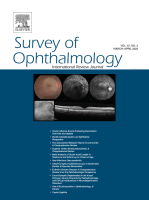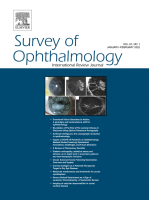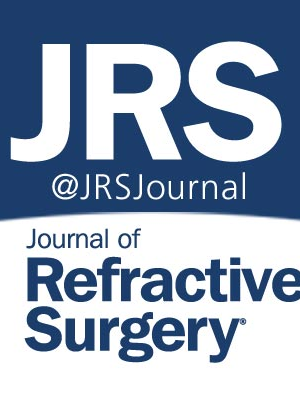No products in the cart.
Ophthalmology Journals, General Ophthalmology
Survey of Ophthalmology Volume 67, Issue 2
SURVEY OF OPHTHALMOLOGY VOLUME 67 • NUMBER 2 • MARCH/APRIL 2022
Ocular adverse events following vaccination: overview and update
Pages 293-306. Cheng, John Yu, BA, and Margo, Curtis E., MD, MPH.
AbstractThe Food and Drug Administration has licensed, approved, and expanded guidelines for dozens of vaccines since 2010. Although advancements in biotechnology have made vaccines more effective and safer, none are completely free from adverse e…
Bacille Calmette-Guérin: An ophthalmic perspective
Pages 307-320. Jain, Manish, DNB, Vadboncoeur, Julie, MD, FRCSC, Garg, Sunir J., MD, FACS, and Biswas, Jyotirmay, MS, FICP.
AbstractVaccines such as bacille Calmette-Guérin (BCG) are known for their heterologous effects mediated through a number of mechanisms, including trained immunity constituted by monocyte-macrophage based innate immunity. Other events such as dire…
The association between vitamin D and uveitis: A comprehensive review
Pages 321-330. Pillar, Shani, MD, and Amer, Radgonde, MD.
AbstractVitamin D plays an important role in both the innate and adaptive immune systems. We review published data on the relationship between uveitis and vitamin D levels or vitamin D-associated gene polymorphisms. A search of the PubMed and Medl…
Superior limbic keratoconjunctivitis: a comprehensive review
Pages 331-341. Lahoti, Sejal, MD, MPH, Weiss, Menachem, MD, Johnson, Daniel A, MD, MBA, and Kheirkhah, Ahmad, MD.
AbstractSuperior limbic keratoconjunctivitis (SLK) is characterized by chronic inflammation of the superior limbus and superior bulbar and tarsal conjunctivae. Patients also often have fine punctate staining of the limbus and adjacent area, superi…
Meta-analysis of ocular axial length in newborns and infants up to 3 years of age
Pages 342-352. Groot, Annabel L.W., MD, Lissenberg-Witte, Birgit I., MD, PhD, van Rijn, Laurentius J., MD, PhD, and Hartong, Dyonne T., MD, PhD.
AbstractIn pediatric ophthalmology it is often necessary to obtain axial length in young children. For children older than 3 years, noncontact biometry can be used. For younger children this is usually not an option, and the clinician needs to rel…
Non-infectious Dacryoadenitis
Pages 353-368. Singh, Swati, MBBS, MS, and Selva, Dinesh, DHSc, FRANZCO, FRACS.
AbstractDacryoadenitis is an inflammation of the lacrimal gland that may have various etiologies with similar presentations. Despite more recent elucidation of specific causes, the management has remained largely unchanged. Hence, the condition re…
Adaptive optics ophthalmoscopy: a systematic review of vascular biomarkers
Pages 369-387. Bakker, Elise, BSc, Dikland, Felix Anne, BSc, van Bakel, Roan, BSc, Andrade De Jesus, Danilo, PhD, Sánchez Brea, Luisa, PhD, Klein, Stefan, PhD, van Walsum, Theo, PhD, Rossant, Florence, PhD, Farías, Daniela Castro, MD, PhD, Grieve, Kate, PhD, and Paques, Michel, MD, PhD.
AbstractRetinal vascular diseases are a leading cause for blindness and partial sight certifications. By applying adaptive optics (AO) to conventional imaging modalities, the microstructures of the retinal vasculature can be observed with high spa…
Erdheim-Chester disease: a comprehensive review from the ophthalmologic perspective
Pages 388-410. Kanakis, Menelaos, MD, PhD, Petrou, Petros, MD, PhD, Lourida, Giota, MD, PhD, and Georgalas, Ilias, MD, PhD.
AbstractErdheim–Chester disease (ECD) is a rare clonal histiocytic neoplasm with less than 1200 documented cases to date. The disease is life-threatening and difficult to recognize, although increasing awareness as well as the integration of clini…
Trans-synaptic degeneration in the visual pathway: Neural connectivity, pathophysiology, and clinical implications in neurodegenerative disorders
Pages 411-426. Sharma, Samridhi, PhD, Chitranshi, Nitin, PhD, Wall, Roshana Vander, M Res, Basavarajappa, Devaraj, PhD, Gupta, Vivek, PhD, Mirzaei, Mehdi, PhD, Graham, Stuart L, FRANZCO, PhD, Klistorner, Alexander, PhD, and You, Yuyi, MD, PhD.
AbstractThere is a strong interrelationship between eye and brain diseases. It has been shown that neurodegenerative changes can spread bidirectionally in the visual pathway along neuronal projections. For example, damage to retinal ganglion cells…
Use of erythropoietin in ophthalmology: a review
Pages 427-439. Feizi, Sepehr, MD, MSc, Alemzadeh-Ansari, Mohammadhasan, MD, Karimian, Farid, MD, and Esfandiari, Hamed, MD.
AbstractErythropoietin (EPO) is a glycoprotein hormone that regulates hematopoiesis in the human body. The presence of EPO and its receptors in different tissues indicates that this hormone has extramedullary effects in other tissues, including th…
Ocular syphilis
Pages 440-462. Furtado, João M., MD PhD, Simões, Milena, MD, Vasconcelos-Santos, Daniel, MD PhD, Oliver, Genevieve F., FRANZCO MOphth, Tyagi, Mudit, MD, Nascimento, Heloisa, MD PhD, Gordon, David L., FRACP, FRCPA, PhD, and Smith, Justine R., FRANZCO PhD.
AbstractMultiple studies around the world suggest that syphilis is re-emerging. Ocular syphilis – with a wide range of presentations, most of which are subtypes of uveitis – has become an increasingly common cause of ocular inflammation over the p…
Sildenafil in ophthalmology: An update
Pages 463-487. Arora, Supriya, MS, FICO, FAICO (vitreoretina), Surakiatchanukul, Thamolwan, MD, Arora, Tarun, MD, FICO, Cagini, Carlo, MD, Lupidi, Marco, MD, PhD, and Chhablani, Jay, MD.
AbstractSildenafil citrate, a selective oral phosphodiesterase 5 inhibitor, is a widely used drug for erectile dysfunction that acts by elevating cGMP levels and causing smooth muscle relaxation. It also has 10% activity against PDE6, a key enzyme…
The cause of myopia development and progression: Theory, evidence, and treatment
Pages 488-509. Medina, Antonio, PhD.
AbstractI review the key findings and our current knowledge of the cause of myopia, making the connections among the reliable observations on myopia development and theory to arrive at a summary of what we know about myopia, the proposed prevailin…
Pediatric uveitis: A comprehensive review
Pages 510-529. Maleki, Arash, MD, Anesi, Stephen D., MD, FACS, Look-Why, Sydney, BA, Manhapra, Ambika, BA, and Foster, C. Stephen, MD, FACS, FACR.
Highlights•In this review article, different aspects of pediatric uveitis were reviewed. The mechanisms of non-infectious uveitis including autoimmune and autoinflammatory, the risk factors for developing uveitis in children with systemic rheumato…
Ophthalmologic manifestations as the initial presentation of chronic myeloid leukemia: A review
Pages 530-543. Yassin, Mohamed A., MBBS, MSc, Ata, Fateen, MBBS, Mohamed, Shehab F., MD, Alkhateeb, Ameen, MD, Naeem, Usman, MD, Al-Qatami, Ahmed I., MD, Nashwan, Abdulqadir J., MSc, and Fernyhough, Liam J., MD.
AbstractThe presentation of chronic myeloid leukemia (CML) can be variable and related to the phase of the disease. It can manifest a wide range of symptoms and signs; ocular involvement is reported in patients with leukemia at the time of diagnos…
Cysticercosis in ophthalmology
Pages 544-569. Pujari, Amar, MD, Bhaskaran, Karthika, MD, Modaboyina, Sujeeth, MD, Das, Deepshekhar, MD, Saluja, Gunjan, MD, Samdani, Asha, MD, Singh, Pallavi, MD, Bajaj, Mandeep S, MD, and Sharma, Namrata, MD.
AbstractCysticercosis is caused by Taenia solium, a cestode or tapeworm that preferentially affects the subcutaneous tissue, brain, muscle, and the eye. It is traditionally a disease of low socioeconomic regions, but large-scale population migrati…
Choroidal macrovessel: Systematic review and analysis of anatomic origin
Pages 570-578. Bowen, Randy Christopher, MD, MS, Raval, Vishal, MD, Soto, Hansell, MD, and Singh, Arun D., MD.
Highlights•There are several proposed hypotheses for the anatomic origin of choroidal macrovessels in the current literature with no clear conclusion. •Anatomic choroidal macrovessel overlay comparison from 20 cases showed vessel patterns consiste…
Multimodal imaging in pachychoroid spectrum
Pages 579-590. Safi, Hamid, MD, MPH, Ahmadieh, Hamid, MD, Hassanpour, Kiana, MD, and Safi, Sare, PhD.
AbstractDiagnostic investigation on pachychoroid spectrum disease (PSD) has been growing along with the rapid advancement of imaging technology. In optical coherence tomography (OCT)-based studies, choroidal thickness profile, luminal and stromal …
Associations of refractive errors and retinal changes measured by optical coherence tomography: A systematic review and meta-analysis
Pages 591-607. Salehi, Mohammad Amin, MD, Nowroozi, Ali, MD, Gouravani, Mahdi, MD, MPH, Mohammadi, Soheil, MD, MPH, and Arevalo, J. Fernando, MD, PhD.
Highlights•High myopes show thinner retinal nerve fiber layer and pRNFL, except for temporal quadrants. •High myopes show thinner macular thickness, parafovea, perifovea, fovea and foveola. •Moderate myopes show thinner pRNFL in superior, inferior…
The role of topical N-acetylcysteine in ocular therapeutics
Pages 608-622. Eghtedari, Yas, BMedSc, BSc (Hons), MD, Oh, Lawrence J., BMed, MD, Girolamo, Nick Di, BSc, PhD, and Watson, Stephanie L., BSc (Med), MBBS, PhD, FRANZCO.
AbstractN-acetylcysteine (NAC) was first discovered as a mucolytic agent in 1960. We investigate the role of topical NAC in ocular therapeutics, including its mechanism of action, current applications, and adverse effects. A systematic search of p…
The best course of action
Pages 623-627. Vaphiades, Michael S., DO, and Nudleman, Eric, MD, PhD.
AbstractAn 11-year-old girl noted gradual visual loss in the right eye for 1 year with subfoveal yellow deposits in both eyes. Optical coherence tomography, electro-oculogram and electroretinogram was in-keeping with Best Disease. This disorder is…
Letter to the editor regarding: Congenital aniridia – a comprehensive review of clinical features and therapeutic approaches
Pages 628-628. Brandt, James D., MD.
Dear Editor: I enjoyed reading the excellent article by Landsend and colleagues in which they reviewed the clinical features of congenital aniridia and therapeutic approaches to the management of the syndrome. Because glaucoma is such a dominant c…
Authors’ response to letter to the editor: Congenital aniridia – a comprehensive review of clinical features and therapeutic approach
Pages 629-630. Landsend, Erlend C.S., MD, PhD, Lagali, Neil, PhD, and Utheim, Tor P., MD, PhD.
We thank Professor Brandt for his comments to our review article «Congenital aniridia – A comprehensive review of clinical features and therapeutic approach». The letter importantly highlights that central corneal thickness (CCT) is increased in p…
Comment on: “Meta-analysis of ocular axial length in newborns and infants up to 3 years of age”
Pages 631-632. Aghajani, Ali, MD, and Chaibakhsh, Samira, PhD.
I read with interest the recent study by Groot and coworkers entitled ”Meta-analysis of ocular axial length in newborns and infants up to 3 years of age” 3.In this paper the authors merged the axial length data in 0-3 year old infants in the liter…
Author’s reply to: Comment on: “Meta-analysis of ocular axial length in newborns and infants until three years of age”
Pages 633-635. Groot, Annabel L.W., MD, Lissenberg-Witte, Birgit I., MD, PhD, van Rijn, Laurentius J., MD, PhD, and Hartong, Dyonne T., MD, PhD.
We thank our colleagues Aghajani and Chaibakhsh for thoroughly reading our paper and taking the time to comment on the results. We would like to reply to their statements with the following. They state that 1. our search strategy is not mentioned …


![[Original PDF] 2019-2020 BCSC (Basic and Clinical Science Course), Section 10: Glaucoma](https://ophthalmologyebooks.store/wp-content/uploads/2022/12/9781681041452-300x400.jpg)


